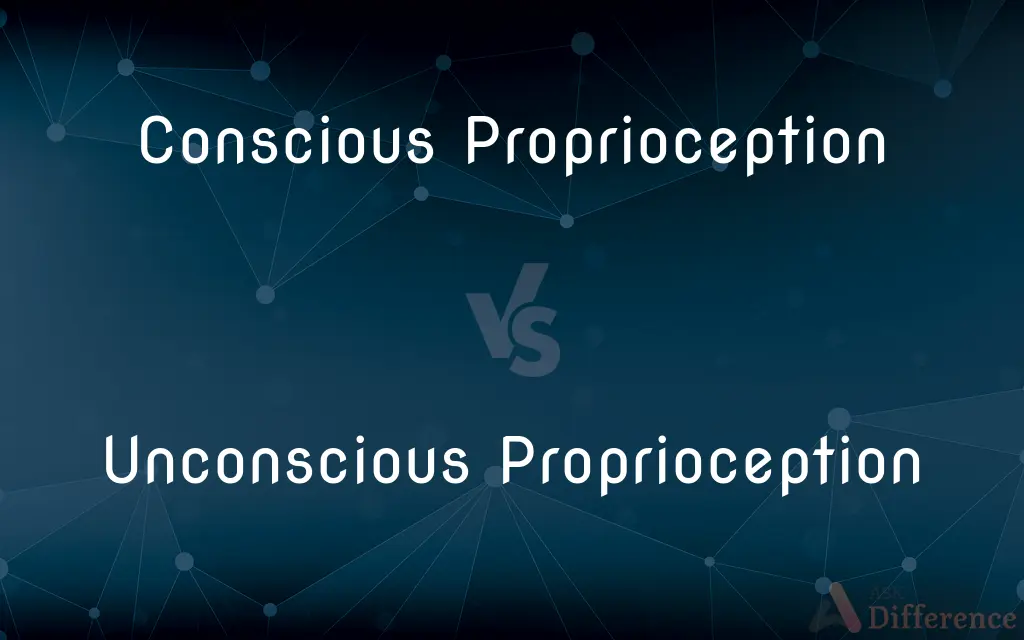Conscious Proprioception vs. Unconscious Proprioception — What's the Difference?
Edited by Tayyaba Rehman — By Fiza Rafique — Published on December 17, 2023
Conscious Proprioception refers to our aware perception of body position and movements. Unconscious Proprioception operates automatically, informing reflexes and posture without awareness.

Difference Between Conscious Proprioception and Unconscious Proprioception
Table of Contents
ADVERTISEMENT
Key Differences
Conscious Proprioception is the sense through which we are actively aware of the position and movements of our body parts. On the other hand, Unconscious Proprioception operates behind the scenes, without our active awareness, guiding our body's reflexive actions.
When you intentionally move your hand or adjust your posture and recognize these movements, that's Conscious Proprioception at play. In contrast, Unconscious Proprioception is at work when your body instinctively adjusts its posture on an uneven surface, even if you're not actively thinking about it.
Conscious Proprioception is essential for tasks that require focused attention to body positioning, like dancing or playing sports. Meanwhile, Unconscious Proprioception is vital for automated responses and maintaining balance, ensuring we don't constantly have to think about every minor adjustment.
In terms of neural pathways, Conscious Proprioception information typically travels up the spinal cord to the brain's parietal lobes. For Unconscious Proprioception, the information is primarily directed to the cerebellum, which manages balance and coordination.
Injuries or disorders can affect both Conscious and Unconscious Proprioception. For instance, someone may be aware they're stumbling (Conscious Proprioception) but may not reflexively correct their posture (Unconscious Proprioception).
ADVERTISEMENT
Comparison Chart
Awareness Level
Actively perceived and recognized.
Operates without active awareness.
Function
Helps in intentional body movements.
Regulates reflexes and posture automatically.
Applications
Important for focused tasks like sports.
Vital for maintaining balance and coordination.
Neural Pathway
Information travels to the parietal lobes.
Primarily directed to the cerebellum.
Effect of Injuries
May impact deliberate movement recognition.
Can affect automatic posture adjustments and balance.
Compare with Definitions
Conscious Proprioception
Conscious Proprioception aids in tasks requiring focused body positioning.
Athletes rely on Conscious Proprioception to perfect their techniques.
Unconscious Proprioception
Unconscious Proprioception regulates automatic body adjustments.
Even in sleep, her Unconscious Proprioception kept her from falling off the bed.
Conscious Proprioception
Conscious Proprioception is the perception of intentional bodily adjustments.
She used Conscious Proprioception to correct her posture during yoga.
Unconscious Proprioception
Unconscious Proprioception works behind the scenes in body coordination.
Even without thinking, his Unconscious Proprioception allowed him to catch a falling object.
Conscious Proprioception
Conscious Proprioception is the active awareness of body positioning.
While dancing, her Conscious Proprioception helped her maintain perfect form.
Unconscious Proprioception
Unconscious Proprioception operates without our direct awareness.
He didn't realize he was adjusting his balance, a testament to Unconscious Proprioception.
Conscious Proprioception
Conscious Proprioception lets us cognitively understand our physical state.
Awareness of his leg's position, thanks to Conscious Proprioception, helped him avoid an obstacle.
Unconscious Proprioception
Unconscious Proprioception ensures body balance without cognitive effort.
While daydreaming, her Unconscious Proprioception kept her walking straight on the sidewalk.
Conscious Proprioception
Conscious Proprioception allows recognition of deliberate movements.
Through Conscious Proprioception, he knew exactly where his hand was without looking.
Unconscious Proprioception
Unconscious Proprioception guides reflexive bodily reactions.
His quick reflex to a stumble was a result of Unconscious Proprioception.
Common Curiosities
How does Unconscious Proprioception differ from Conscious Proprioception?
Unconscious Proprioception operates automatically without our direct awareness, while Conscious Proprioception requires active perception.
Why is Conscious Proprioception important in sports?
Conscious Proprioception helps athletes recognize and adjust their body positions intentionally, aiding in performance.
Is Conscious Proprioception always active?
No, Conscious Proprioception is active when we're intentionally aware of our body's movements and positions.
Can disorders impact Conscious Proprioception?
Yes, certain neurological disorders can impair Conscious Proprioception, affecting movement recognition.
Can we train our Conscious Proprioception?
Yes, activities like yoga, dance, or martial arts can enhance Conscious Proprioception awareness.
How do injuries affect Unconscious Proprioception?
Injuries can disrupt Unconscious Proprioception, leading to balance issues and poor reflexive adjustments.
Do animals have Unconscious Proprioception?
Yes, animals also possess Unconscious Proprioception to maintain balance and coordinate movements.
What is Conscious Proprioception?
Conscious Proprioception is the active awareness of our body's position and movements.
How does Unconscious Proprioception help in daily life?
Unconscious Proprioception maintains balance and coordinates reflexive actions without needing our active thought.
Is Unconscious Proprioception vital for walking?
Yes, Unconscious Proprioception ensures balance and automated foot placements while walking.
Why don't we always notice Unconscious Proprioception?
Unconscious Proprioception operates behind the scenes without requiring our active cognition, making it unnoticeable.
What part of the brain is involved in Unconscious Proprioception?
The cerebellum primarily handles Unconscious Proprioception, managing balance and coordination.
How can I test my Conscious Proprioception?
Activities like closing your eyes and touching your nose can help test your Conscious Proprioception.
Can training improve both types of proprioception?
Yes, specific exercises and therapies can enhance both Conscious and Unconscious Proprioception.
Why is it called "Conscious" and "Unconscious" Proprioception?
The terms reflect whether the proprioceptive process operates with active awareness (Conscious) or automatically without perception (Unconscious).
Share Your Discovery

Previous Comparison
Branched Polymer vs. Linear Polymer
Next Comparison
Tatkal vs. Premium TatkalAuthor Spotlight
Written by
Fiza RafiqueFiza Rafique is a skilled content writer at AskDifference.com, where she meticulously refines and enhances written pieces. Drawing from her vast editorial expertise, Fiza ensures clarity, accuracy, and precision in every article. Passionate about language, she continually seeks to elevate the quality of content for readers worldwide.
Edited by
Tayyaba RehmanTayyaba Rehman is a distinguished writer, currently serving as a primary contributor to askdifference.com. As a researcher in semantics and etymology, Tayyaba's passion for the complexity of languages and their distinctions has found a perfect home on the platform. Tayyaba delves into the intricacies of language, distinguishing between commonly confused words and phrases, thereby providing clarity for readers worldwide.














































